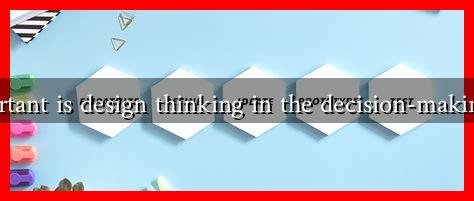-
Table of Contents
How Important is Design Thinking in the Decision-Making Process?
In today’s fast-paced and ever-evolving business landscape, organizations are constantly seeking innovative ways to solve complex problems and make informed decisions. One approach that has gained significant traction is design thinking. This human-centered methodology not only fosters creativity but also enhances the decision-making process by prioritizing user needs and experiences. In this article, we will explore the importance of design thinking in decision-making, supported by relevant examples, case studies, and statistics.
Understanding Design Thinking
Design thinking is a problem-solving framework that emphasizes empathy, ideation, and experimentation. It typically involves five stages: empathize, define, ideate, prototype, and test. This iterative process encourages teams to understand the user’s perspective, define the core problem, brainstorm potential solutions, create prototypes, and test them in real-world scenarios.
The Role of Design Thinking in Decision-Making
Design thinking plays a crucial role in enhancing decision-making processes across various sectors. Here are some key aspects of its importance:
- User-Centric Approach: By focusing on the needs and experiences of users, design thinking ensures that decisions are grounded in real-world insights. This leads to solutions that are more likely to resonate with the target audience.
- Encourages Collaboration: Design thinking promotes cross-functional collaboration, bringing together diverse perspectives that can lead to more innovative solutions. This collaborative environment fosters creativity and encourages team members to share ideas freely.
- Reduces Risk: By prototyping and testing ideas before full-scale implementation, organizations can identify potential pitfalls early in the process. This iterative approach minimizes the risk of costly mistakes and enhances the overall quality of decisions.
- Fosters Innovation: Design thinking encourages out-of-the-box thinking, allowing teams to explore unconventional solutions. This can lead to breakthrough innovations that set organizations apart from their competitors.
Case Studies: Design Thinking in Action
Several organizations have successfully integrated design thinking into their decision-making processes, yielding impressive results. Here are a few notable examples:
- IBM: IBM adopted design thinking to transform its product development process. By focusing on user needs and involving clients in the design process, IBM was able to reduce development time by 75% and increase customer satisfaction significantly.
- Airbnb: Airbnb utilized design thinking to enhance its user experience. By empathizing with both hosts and guests, the company identified pain points and implemented solutions that improved the overall platform, leading to a 30% increase in bookings.
- Procter & Gamble: P&G embraced design thinking to innovate its product lines. The company established a dedicated design thinking team that collaborated with consumers to co-create products, resulting in a 50% increase in new product success rates.
Statistics Supporting Design Thinking
Research indicates that organizations employing design thinking see tangible benefits. According to a study by the Design Management Institute, design-driven companies outperformed the S&P 500 by 228% over ten years. Furthermore, a report by McKinsey found that companies that integrate design into their decision-making processes experience a 32% increase in customer satisfaction and a 56% increase in employee engagement.
Conclusion: The Future of Decision-Making
In conclusion, design thinking is not just a buzzword; it is a vital approach that enhances the decision-making process across various industries. By prioritizing user needs, fostering collaboration, reducing risk, and encouraging innovation, organizations can make more informed and effective decisions. As the business landscape continues to evolve, embracing design thinking will be essential for companies looking to stay competitive and relevant.
For further reading on design thinking and its applications, you can explore resources from the IDEO U and McKinsey & Company.

